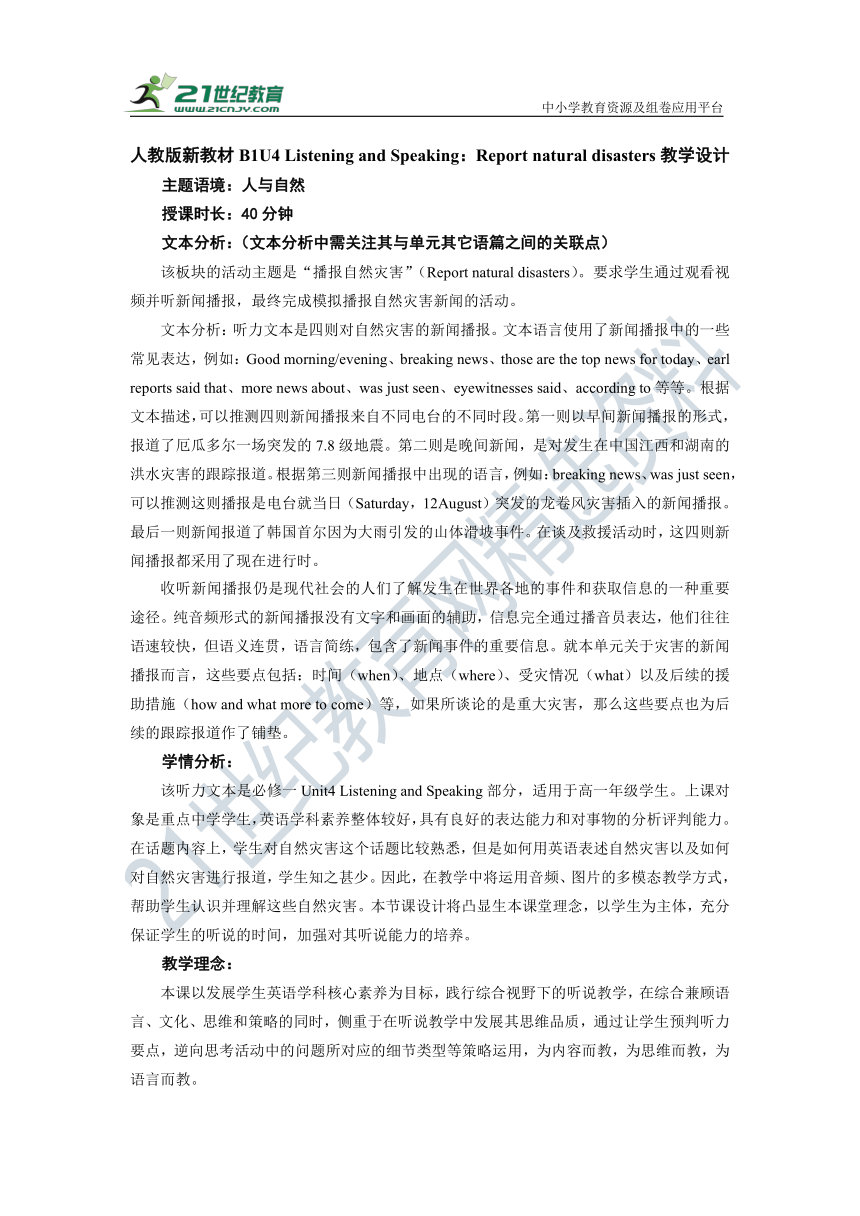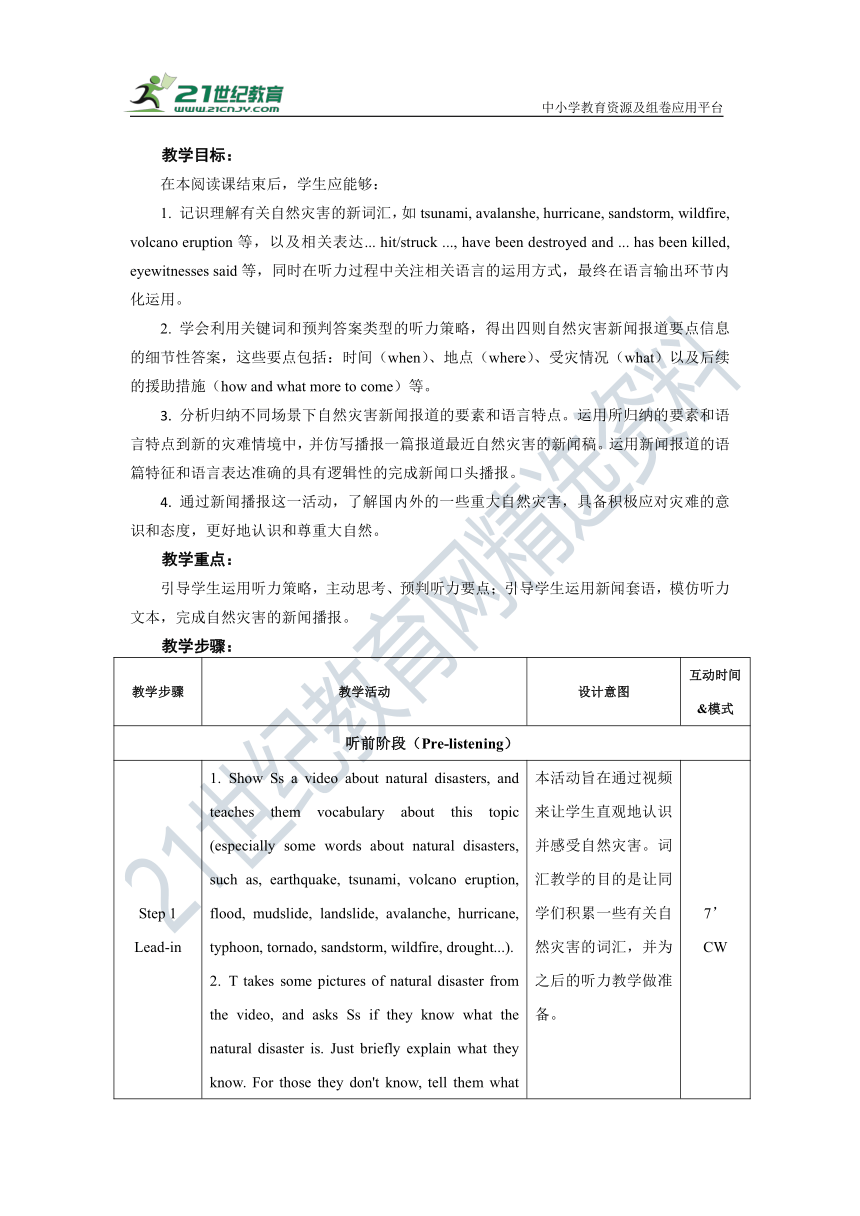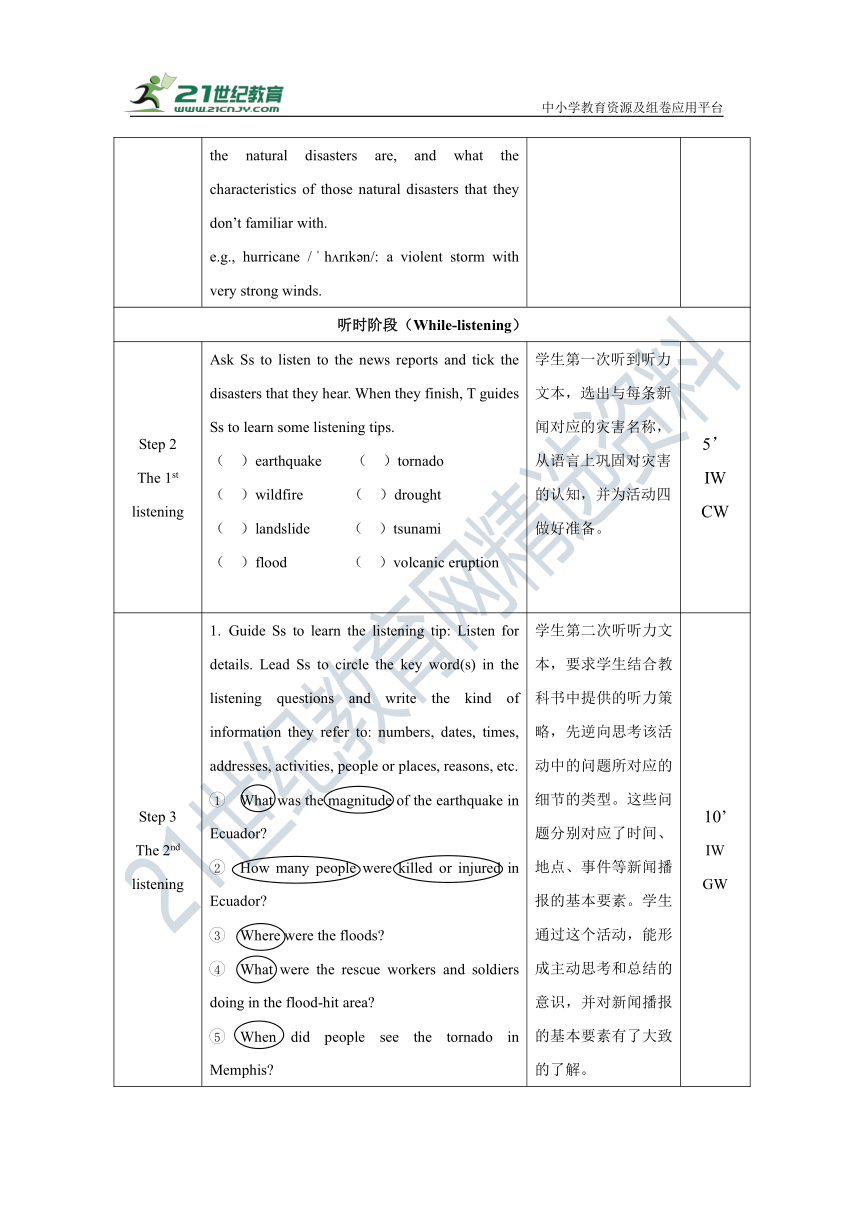人教版(2019)必修第一册 Unit 4 Natural disasters Listening and Speaking 教案
文档属性
| 名称 | 人教版(2019)必修第一册 Unit 4 Natural disasters Listening and Speaking 教案 |  | |
| 格式 | docx | ||
| 文件大小 | 275.1KB | ||
| 资源类型 | 试卷 | ||
| 版本资源 | 人教版(2019) | ||
| 科目 | 英语 | ||
| 更新时间 | 2024-09-22 09:12:01 | ||
图片预览



文档简介
中小学教育资源及组卷应用平台
人教版新教材B1U4 Listening and Speaking:Report natural disasters教学设计
主题语境:人与自然
授课时长:40分钟
文本分析:(文本分析中需关注其与单元其它语篇之间的关联点)
该板块的活动主题是“播报自然灾害”(Report natural disasters)。要求学生通过观看视频并听新闻播报,最终完成模拟播报自然灾害新闻的活动。
文本分析:听力文本是四则对自然灾害的新闻播报。文本语言使用了新闻播报中的一些常见表达,例如:Good morning/evening、breaking news、those are the top news for today、earl reports said that、more news about、was just seen、eyewitnesses said、according to等等。根据文本描述,可以推测四则新闻播报来自不同电台的不同时段。第一则以早间新闻播报的形式,报道了厄瓜多尔一场突发的7.8级地震。第二则是晚间新闻,是对发生在中国江西和湖南的洪水灾害的跟踪报道。根据第三则新闻播报中出现的语言,例如:breaking news、was just seen,可以推测这则播报是电台就当日(Saturday,12August)突发的龙卷风灾害插入的新闻播报。最后一则新闻报道了韩国首尔因为大雨引发的山体滑坡事件。在谈及救援活动时,这四则新闻播报都采用了现在进行时。
收听新闻播报仍是现代社会的人们了解发生在世界各地的事件和获取信息的一种重要途径。纯音频形式的新闻播报没有文字和画面的辅助,信息完全通过播音员表达,他们往往语速较快,但语义连贯,语言简练,包含了新闻事件的重要信息。就本单元关于灾害的新闻播报而言,这些要点包括:时间(when)、地点(where)、受灾情况(what)以及后续的援助措施(how and what more to come)等,如果所谈论的是重大灾害,那么这些要点也为后续的跟踪报道作了铺垫。
学情分析:
该听力文本是必修一Unit4 Listening and Speaking部分,适用于高一年级学生。上课对象是重点中学学生,英语学科素养整体较好,具有良好的表达能力和对事物的分析评判能力。在话题内容上,学生对自然灾害这个话题比较熟悉,但是如何用英语表述自然灾害以及如何对自然灾害进行报道,学生知之甚少。因此,在教学中将运用音频、图片的多模态教学方式,帮助学生认识并理解这些自然灾害。本节课设计将凸显生本课堂理念,以学生为主体,充分保证学生的听说的时间,加强对其听说能力的培养。
教学理念:
本课以发展学生英语学科核心素养为目标,践行综合视野下的听说教学,在综合兼顾语言、文化、思维和策略的同时,侧重于在听说教学中发展其思维品质,通过让学生预判听力要点,逆向思考活动中的问题所对应的细节类型等策略运用,为内容而教,为思维而教,为语言而教。
教学目标:
在本阅读课结束后,学生应能够:
记识理解有关自然灾害的新词汇,如tsunami, avalanshe, hurricane, sandstorm, wildfire, volcano eruption等,以及相关表达... hit/struck ..., have been destroyed and ... has been killed, eyewitnesses said等,同时在听力过程中关注相关语言的运用方式,最终在语言输出环节内化运用。
学会利用关键词和预判答案类型的听力策略,得出四则自然灾害新闻报道要点信息的细节性答案,这些要点包括:时间(when)、地点(where)、受灾情况(what)以及后续的援助措施(how and what more to come)等。
分析归纳不同场景下自然灾害新闻报道的要素和语言特点。运用所归纳的要素和语言特点到新的灾难情境中,并仿写播报一篇报道最近自然灾害的新闻稿。运用新闻报道的语篇特征和语言表达准确的具有逻辑性的完成新闻口头播报。
通过新闻播报这一活动,了解国内外的一些重大自然灾害,具备积极应对灾难的意识和态度,更好地认识和尊重大自然。
教学重点:
引导学生运用听力策略,主动思考、预判听力要点;引导学生运用新闻套语,模仿听力文本,完成自然灾害的新闻播报。
教学步骤:
教学步骤 教学活动 设计意图 互动时间&模式
听前阶段(Pre-listening)
Step 1 Lead-in Show Ss a video about natural disasters, and teaches them vocabulary about this topic (especially some words about natural disasters, such as, earthquake, tsunami, volcano eruption, flood, mudslide, landslide, avalanche, hurricane, typhoon, tornado, sandstorm, wildfire, drought...). T takes some pictures of natural disaster from the video, and asks Ss if they know what the natural disaster is. Just briefly explain what they know. For those they don't know, tell them what the natural disasters are, and what the characteristics of those natural disasters that they don’t familiar with. e.g., hurricane / h r k n/: a violent storm with very strong winds. 本活动旨在通过视频来让学生直观地认识并感受自然灾害。词汇教学的目的是让同学们积累一些有关自然灾害的词汇,并为之后的听力教学做准备。 7’ CW
听时阶段(While-listening)
Step 2 The 1st listening Ask Ss to listen to the news reports and tick the disasters that they hear. When they finish, T guides Ss to learn some listening tips. ( )earthquake ( )tornado ( )wildfire ( )drought ( )landslide ( )tsunami ( )flood ( )volcanic eruption 学生第一次听到听力文本,选出与每条新闻对应的灾害名称,从语言上巩固对灾害的认知,并为活动四做好准备。 5’ IW CW
Step 3 The 2nd listening Guide Ss to learn the listening tip: Listen for details. Lead Ss to circle the key word(s) in the listening questions and write the kind of information they refer to: numbers, dates, times, addresses, activities, people or places, reasons, etc. What was the magnitude of the earthquake in Ecuador How many people were killed or injured in Ecuador Where were the floods What were the rescue workers and soldiers doing in the flood-hit area When did people see the tornado in Memphis Which buildings were damaged in Seoul What caused the landslide in Seoul Asks Ss to listen again and answer the questions above. (The four news reports should be played one by one). Report 1: question 1 and 2 Report 2: question 3 and 4 Report 3: question 5 Report 4: question 6 and 7 (Suggested answers: 7.8 About 230 were killed and more than 1500 were injured. In central China. They are working day and night to make sure that people are safe. At 9:25 a.m. A library and a supermarket. By heavy rain that had fallen in the last week.) 学生第二次听听力文本,要求学生结合教科书中提供的听力策略,先逆向思考该活动中的问题所对应的细节的类型。这些问题分别对应了时间、地点、事件等新闻播报的基本要素。学生通过这个活动,能形成主动思考和总结的意识,并对新闻播报的基本要素有了大致的了解。 10’ IW GW
听后阶段(Post-listening)
Step 4 Language learning Encourage Ss to think about the following questions: What important factors are included in these reports (time, place, disaster, damage, rescue) What expressions are used in these news reports to introduce the following information What tense should be used to describe... Time & Place (simple present tense + simple present tense) It’s/Today is ... A strong earthquake hit ... A tornado was just seen in ... Damage (simple present tense + simple present tense) The 7.8-magnitude earthquake damaged ... ... were killed/injured. ... have been destroyed but no one has been killed. Rescue work (present continuous tense) ... are helping the survivors. ... are working day and night to make sure that people are safe. ... are bringing food and water to ... Typical expressions to report news: Good morning/evening breaking news those are the top news for today early reports said that more news about ... was just seen eyewitnesses said according to ... 让学生对文本信息有更深入的理解,实现对文本内容的整体认识;让学生组织整合文本细节信息和语言表达,发现新闻报道文体的特征,实现一定的语言输入,为之后的输出活动做铺垫。 10’ IW GW CW
Step 5 Speaking Make Ss read about the disasters and prepare a short news report on one of them (T give a sample news report and uses different colors to mark different information, such as data, when, where, what, examples…, which helps Ss have a clear understanding.) Invite Ss to present their own news reports to the class and judge whether the report is a good copy of the origin, and what its strengths and weaknesses are. 锻炼学生口语表达能力,实现从听到说的过渡;检测学生对听力文本的理解,锻炼他们的分析思维;让学生将刚才获得的语言输入进行内化与应用。 8’ IW GW CW
Step 6 Homework Ask Ss to find the latest news about a natural disaster, write a news report, and broadcast it like a news reporter. 激发学生根据所学知识进行再创造,从而启发学生自主性思考。
备注:Ss: Students IW: Individual work GW: Group work CW: Class work
板书设计:
Reporting natural disasters
earthquake
tsunami
volcano eruption
flood
mudslide
landslide
Avalanche
hurricane
typhoon
tornado
sandstorm
wildfire
drought
人教版新教材B1U4 Listening and Speaking:Report natural disasters教学设计
主题语境:人与自然
授课时长:40分钟
文本分析:(文本分析中需关注其与单元其它语篇之间的关联点)
该板块的活动主题是“播报自然灾害”(Report natural disasters)。要求学生通过观看视频并听新闻播报,最终完成模拟播报自然灾害新闻的活动。
文本分析:听力文本是四则对自然灾害的新闻播报。文本语言使用了新闻播报中的一些常见表达,例如:Good morning/evening、breaking news、those are the top news for today、earl reports said that、more news about、was just seen、eyewitnesses said、according to等等。根据文本描述,可以推测四则新闻播报来自不同电台的不同时段。第一则以早间新闻播报的形式,报道了厄瓜多尔一场突发的7.8级地震。第二则是晚间新闻,是对发生在中国江西和湖南的洪水灾害的跟踪报道。根据第三则新闻播报中出现的语言,例如:breaking news、was just seen,可以推测这则播报是电台就当日(Saturday,12August)突发的龙卷风灾害插入的新闻播报。最后一则新闻报道了韩国首尔因为大雨引发的山体滑坡事件。在谈及救援活动时,这四则新闻播报都采用了现在进行时。
收听新闻播报仍是现代社会的人们了解发生在世界各地的事件和获取信息的一种重要途径。纯音频形式的新闻播报没有文字和画面的辅助,信息完全通过播音员表达,他们往往语速较快,但语义连贯,语言简练,包含了新闻事件的重要信息。就本单元关于灾害的新闻播报而言,这些要点包括:时间(when)、地点(where)、受灾情况(what)以及后续的援助措施(how and what more to come)等,如果所谈论的是重大灾害,那么这些要点也为后续的跟踪报道作了铺垫。
学情分析:
该听力文本是必修一Unit4 Listening and Speaking部分,适用于高一年级学生。上课对象是重点中学学生,英语学科素养整体较好,具有良好的表达能力和对事物的分析评判能力。在话题内容上,学生对自然灾害这个话题比较熟悉,但是如何用英语表述自然灾害以及如何对自然灾害进行报道,学生知之甚少。因此,在教学中将运用音频、图片的多模态教学方式,帮助学生认识并理解这些自然灾害。本节课设计将凸显生本课堂理念,以学生为主体,充分保证学生的听说的时间,加强对其听说能力的培养。
教学理念:
本课以发展学生英语学科核心素养为目标,践行综合视野下的听说教学,在综合兼顾语言、文化、思维和策略的同时,侧重于在听说教学中发展其思维品质,通过让学生预判听力要点,逆向思考活动中的问题所对应的细节类型等策略运用,为内容而教,为思维而教,为语言而教。
教学目标:
在本阅读课结束后,学生应能够:
记识理解有关自然灾害的新词汇,如tsunami, avalanshe, hurricane, sandstorm, wildfire, volcano eruption等,以及相关表达... hit/struck ..., have been destroyed and ... has been killed, eyewitnesses said等,同时在听力过程中关注相关语言的运用方式,最终在语言输出环节内化运用。
学会利用关键词和预判答案类型的听力策略,得出四则自然灾害新闻报道要点信息的细节性答案,这些要点包括:时间(when)、地点(where)、受灾情况(what)以及后续的援助措施(how and what more to come)等。
分析归纳不同场景下自然灾害新闻报道的要素和语言特点。运用所归纳的要素和语言特点到新的灾难情境中,并仿写播报一篇报道最近自然灾害的新闻稿。运用新闻报道的语篇特征和语言表达准确的具有逻辑性的完成新闻口头播报。
通过新闻播报这一活动,了解国内外的一些重大自然灾害,具备积极应对灾难的意识和态度,更好地认识和尊重大自然。
教学重点:
引导学生运用听力策略,主动思考、预判听力要点;引导学生运用新闻套语,模仿听力文本,完成自然灾害的新闻播报。
教学步骤:
教学步骤 教学活动 设计意图 互动时间&模式
听前阶段(Pre-listening)
Step 1 Lead-in Show Ss a video about natural disasters, and teaches them vocabulary about this topic (especially some words about natural disasters, such as, earthquake, tsunami, volcano eruption, flood, mudslide, landslide, avalanche, hurricane, typhoon, tornado, sandstorm, wildfire, drought...). T takes some pictures of natural disaster from the video, and asks Ss if they know what the natural disaster is. Just briefly explain what they know. For those they don't know, tell them what the natural disasters are, and what the characteristics of those natural disasters that they don’t familiar with. e.g., hurricane / h r k n/: a violent storm with very strong winds. 本活动旨在通过视频来让学生直观地认识并感受自然灾害。词汇教学的目的是让同学们积累一些有关自然灾害的词汇,并为之后的听力教学做准备。 7’ CW
听时阶段(While-listening)
Step 2 The 1st listening Ask Ss to listen to the news reports and tick the disasters that they hear. When they finish, T guides Ss to learn some listening tips. ( )earthquake ( )tornado ( )wildfire ( )drought ( )landslide ( )tsunami ( )flood ( )volcanic eruption 学生第一次听到听力文本,选出与每条新闻对应的灾害名称,从语言上巩固对灾害的认知,并为活动四做好准备。 5’ IW CW
Step 3 The 2nd listening Guide Ss to learn the listening tip: Listen for details. Lead Ss to circle the key word(s) in the listening questions and write the kind of information they refer to: numbers, dates, times, addresses, activities, people or places, reasons, etc. What was the magnitude of the earthquake in Ecuador How many people were killed or injured in Ecuador Where were the floods What were the rescue workers and soldiers doing in the flood-hit area When did people see the tornado in Memphis Which buildings were damaged in Seoul What caused the landslide in Seoul Asks Ss to listen again and answer the questions above. (The four news reports should be played one by one). Report 1: question 1 and 2 Report 2: question 3 and 4 Report 3: question 5 Report 4: question 6 and 7 (Suggested answers: 7.8 About 230 were killed and more than 1500 were injured. In central China. They are working day and night to make sure that people are safe. At 9:25 a.m. A library and a supermarket. By heavy rain that had fallen in the last week.) 学生第二次听听力文本,要求学生结合教科书中提供的听力策略,先逆向思考该活动中的问题所对应的细节的类型。这些问题分别对应了时间、地点、事件等新闻播报的基本要素。学生通过这个活动,能形成主动思考和总结的意识,并对新闻播报的基本要素有了大致的了解。 10’ IW GW
听后阶段(Post-listening)
Step 4 Language learning Encourage Ss to think about the following questions: What important factors are included in these reports (time, place, disaster, damage, rescue) What expressions are used in these news reports to introduce the following information What tense should be used to describe... Time & Place (simple present tense + simple present tense) It’s/Today is ... A strong earthquake hit ... A tornado was just seen in ... Damage (simple present tense + simple present tense) The 7.8-magnitude earthquake damaged ... ... were killed/injured. ... have been destroyed but no one has been killed. Rescue work (present continuous tense) ... are helping the survivors. ... are working day and night to make sure that people are safe. ... are bringing food and water to ... Typical expressions to report news: Good morning/evening breaking news those are the top news for today early reports said that more news about ... was just seen eyewitnesses said according to ... 让学生对文本信息有更深入的理解,实现对文本内容的整体认识;让学生组织整合文本细节信息和语言表达,发现新闻报道文体的特征,实现一定的语言输入,为之后的输出活动做铺垫。 10’ IW GW CW
Step 5 Speaking Make Ss read about the disasters and prepare a short news report on one of them (T give a sample news report and uses different colors to mark different information, such as data, when, where, what, examples…, which helps Ss have a clear understanding.) Invite Ss to present their own news reports to the class and judge whether the report is a good copy of the origin, and what its strengths and weaknesses are. 锻炼学生口语表达能力,实现从听到说的过渡;检测学生对听力文本的理解,锻炼他们的分析思维;让学生将刚才获得的语言输入进行内化与应用。 8’ IW GW CW
Step 6 Homework Ask Ss to find the latest news about a natural disaster, write a news report, and broadcast it like a news reporter. 激发学生根据所学知识进行再创造,从而启发学生自主性思考。
备注:Ss: Students IW: Individual work GW: Group work CW: Class work
板书设计:
Reporting natural disasters
earthquake
tsunami
volcano eruption
flood
mudslide
landslide
Avalanche
hurricane
typhoon
tornado
sandstorm
wildfire
drought
